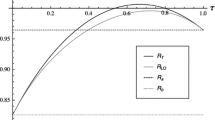Abstract
An adaptation of the definition of the basic reproduction number R 0 to time-periodic seasonal models was suggested a few years ago. However, its biological interpretation remained unclear. The present paper shows that in demography, this R 0 is the asymptotic ratio of total births in two successive generations of the family tree. In epidemiology, it is the asymptotic ratio of total infections in two successive generations of the infection tree. This result is compared with other recent work.
Similar content being viewed by others
References
Ackleh AS, Chiquet RA (2009) The global dynamics of a discrete juvenile–adult model with continuous and seasonal reproduction. J Biol Dyn 3: 101–115
Ackleh AS, Chiquet RA, Zhang P (2011) A discrete dispersal model with constant and periodic environments. J Biol Dyn 5: 563–578
Alimov SA, Il’in VA (2011) Green function. In: Encyclopaedia of mathematics. Springer, New York. http://eom.springer.de/G/g045090.htm
Allen LJS, Bolker BM, Lou Y, Nevai AL (2008) Asymptotic profiles of the steady states for an SIS epidemic reaction-diffusion model. Discret Cont Dyn Syst 21: 1–20
Allen LJS, van den Driessche P (2008) The basic reproduction number in some discrete-time epidemic models. J Diff Equa Appl 14: 1127–1147
Assemblée Nationale (2010) Rapport fait au nom de la commission d’enquête sur la manière dont a été programmée, expliquée et gérée la campagne de vaccination contre la grippe A(H1N1). http://www.assemblee-nationale.fr/13/pdf/rap-enq/r2698.pdf
Bacaër N (2007) Approximation of the basic reproduction number R 0 for vector-borne diseases with a periodic vector population. Bull Math Biol 69: 1067–1091
Bacaër N (2009) Periodic matrix population models: growth rate, basic reproduction number and entropy. Bull Math Biol 71: 1781–1792
Bacaër N (2012) The model of Kermack and McKendrick for the plague epidemic in Bombay and the type reproduction number with seasonality. J Math Biol. doi:10.1007/s00285-011-0417-5
Bacaër N, Abdurahman X (2008) Resonance of the epidemic threshold in a periodic environment. J Math Biol 57: 649–673
Bacaër N, Ait Dads EH (2011) Genealogy with seasonality, the basic reproduction number, and the influenza pandemic. J Math Biol 62: 741–762
Bacaër N, Gomes MGM (2009) On the final size of epidemics with seasonality. Bull Math Biol 71: 1954–1966
Bacaër N, Guernaoui S (2006) The epidemic threshold of vector-borne diseases with seasonality. J Math Biol 53: 421–436
Bacaër N, Ouifki R (2007) Growth rate and basic reproduction number for population models with a simple periodic factor. Math Biosci 210: 647–658
Berman A, Plemmons RJ (1994) Nonnegative matrices in the mathematical sciences. SIAM, Philadelphia
Caswell H (2001) Matrix population models: construction, analysis, and interpretation, 2nd edn. Sinauer Associates, Sunderland MA
Caswell H (2009) Stage, age and individual stochasticity in demography. Oikos 118: 1763–1782
Caswell H (2011) Beyond R 0: demographic models for variability of lifetime reproductive output. PLoS ONE 6(6): e20809. doi:10.1371/journal.pone.0020809
Cushing JM, Ackleh AS (2011) A net reproductive number for periodic matrix models. J Biol Dyn. doi:10.1080/17513758.2010.544410
Dautray R, Lions JL (1984) Analyse mathématique et calcul numérique pour les sciences et les techniques. Masson, Paris
Diekmann O, Heesterbeek JAP, Metz JAJ (1990) On the definition and the computation of the basic reproduction ratio R 0 for infectious diseases in heterogeneous populations. J Math Biol 28: 365–382
Dublin LI, Lotka AJ (1925) On the true rate of natural increase. J Am Stat Assoc 150: 305–339
Gedeon T, Bodelón C, Kuenzi A (2010) Hantavirus transmission in sylvan and peridomestic environments. Bull Math Biol 72: 541–564
Hardy GH (2007) A course of pure mathematics (reprint). Rough Draft Printing
Heesterbeek JAP, Roberts MG (1995) Threshold quantities for infectious diseases in periodic environments. J Biol Syst 4: 779–787
Heesterbeek JAP, Roberts MG (2007) The type-reproduction number T in models for infectious disease control. Math Biosci 206: 3–10
Hess P (1991) Periodic–parabolic boundary value problems and positivity. Longman, Harlow
Hunter CM, Caswell H (2005) Selective harvest of sooty shearwater chicks: effects on population dynamics and sustainability. J Anim Ecol 74: 589–600
Inaba H (2012) On a new perspective of the basic reproduction number in heterogeneous environments. J Math Biol. doi:10.1007/s00285-011-0463-z
Jin Y, Lewis MA (2012) Seasonal influences on population spread and persistence in streams: spreading speeds. J Math Biol. doi:10.1007/s00285-011-0465-x
Kingman JFC (1961) A convexity property of positive matrices. Q J Math Oxf 12: 283–284
Krkošek M, Lewis MA (2010) An R 0 theory for source-sink dynamics with application to Dreissena competition. Theor Ecol 3: 25–43
Li CK, Schneider H (2002) Applications of Perron–Frobenius theory to population dynamics. J Math Biol 44: 450–462
Li J, Blakeley D, Smith RJ (2011) The failure of R 0. Comput Math Methods Med. doi:10.1155/2011/527610
Parham PE, Michael E (2010) Modelling the effects of weather and climate change on malaria transmission. Environ Health Persp 118: 620–626
Rebelo C, Margheri A, Bacaër N (2012) Persistence in seasonally forced epidemiological models. J Math Biol. doi:10.1007/s00285-011-0440-6
Roberts MG, Heesterbeek JAP (2003) A new method for estimating the effort required to control an infectious disease. Proc R Soc Lond B 270: 1359–1364
Seneta E (2006) Non-negative matrices and Markov chains. Springer, New York
Smith HL, Thieme HR (2011) Dynamical systems and population persistence. AMS, Providence
Thieme HR (2009) Spectral bound and reproduction number for infinite-dimensional population structure and time heterogeneity. SIAM J Appl Math 70: 188–211
van den Berg F, Bacaër N, Metz JAJ, Lannou C, van den Bosch F (2011) Periodic host absence can select for higher or lower parasite transmission rates. Evol Ecol 25: 121–137
Wang W, Zhao XQ (2008) Threshold dynamics for compartmental epidemic models in periodic environments. J Dyn Diff Equa 20: 699–717
Wesley CL, Allen LJS, Langlais M (2010) Models for the spread and persistence of hantavirus infection in rodents with direct and indirect transmission. Math Biosci Eng 7: 195–211
Author information
Authors and Affiliations
Corresponding author
Rights and permissions
About this article
Cite this article
Bacaër, N., Ait Dads, E.H. On the biological interpretation of a definition for the parameter R 0 in periodic population models. J. Math. Biol. 65, 601–621 (2012). https://doi.org/10.1007/s00285-011-0479-4
Received:
Revised:
Published:
Issue Date:
DOI: https://doi.org/10.1007/s00285-011-0479-4




